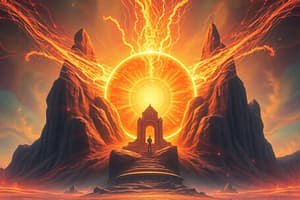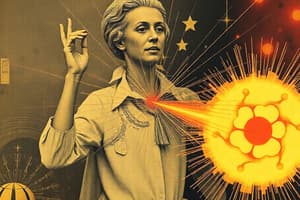Podcast
Questions and Answers
Which equation summarizes the equivalence of energy and matter or mass?
Which equation summarizes the equivalence of energy and matter or mass?
E=mc^2
What does the large value of c^2 mean?
What does the large value of c^2 mean?
It is possible to obtain a tremendous amount of energy from a very small amount of matter.
What is nuclear fission?
What is nuclear fission?
Splitting of a large nucleus into smaller ones with the release of energy.
What occurs when matter 'disappears'?
What occurs when matter 'disappears'?
What is an atom mostly composed of?
What is an atom mostly composed of?
What are the three factors that determine whether particular molecules will split?
What are the three factors that determine whether particular molecules will split?
What are the isotopes of Uranium?
What are the isotopes of Uranium?
How is an isotope specified?
How is an isotope specified?
How is the process of nuclear fission initiated?
How is the process of nuclear fission initiated?
How do you balance a nuclear equation?
How do you balance a nuclear equation?
Which of the following are renewable energy sources? (Select all that apply)
Which of the following are renewable energy sources? (Select all that apply)
According to Einstein's equation E=mc^2, matter can be converted into what?
According to Einstein's equation E=mc^2, matter can be converted into what?
How does the process of nuclear fission produce energy?
How does the process of nuclear fission produce energy?
What are renewable energy sources?
What are renewable energy sources?
Describe how to balance a nuclear equation.
Describe how to balance a nuclear equation.
What is a chain reaction?
What is a chain reaction?
What equation is used to calculate the energy released in a nuclear reaction?
What equation is used to calculate the energy released in a nuclear reaction?
How is electricity generated in a nuclear power plant?
How is electricity generated in a nuclear power plant?
What is the fuel used in a nuclear power station?
What is the fuel used in a nuclear power station?
Describe the components of a nuclear power plant.
Describe the components of a nuclear power plant.
Which two elements are commonly used as a source of neutrons in nuclear reactors?
Which two elements are commonly used as a source of neutrons in nuclear reactors?
What do the control rods in a nuclear reactor absorb?
What do the control rods in a nuclear reactor absorb?
Flashcards are hidden until you start studying
Study Notes
Energy-Matter Equivalence
- E = mc² illustrates the relationship between energy (E) and mass (m), where c is the speed of light (3.00 x 10⁸ m/s).
- c² equals 9.00 x 10¹⁶ m²/s², demonstrating that small amounts of matter can yield vast amounts of energy.
Nuclear Fission
- Nuclear fission involves the splitting of a large nucleus into smaller nuclei, releasing energy due to the mass difference.
- Mass of products is slightly less than reactants; both mass and energy are conserved.
- Heavier nuclei, like uranium and plutonium, may undergo fission, especially when bombarded with high-energy neutrons.
Atoms and Isotopes
- Atoms primarily consist of empty space; most mass is concentrated in the dense nucleus.
- Uranium always contains 92 protons and has isotopes: U-238 (146 neutrons) and U-235 (143 neutrons).
Factors for Molecular Splitting
- Size, number of protons/neutrons, and neutron energy are critical in determining molecular stability and fission potential.
- Light stable atoms like oxygen and chlorine do not split, but heavy atoms like uranium do.
Nuclear Reactions and Energy
- Nuclear fission can release additional neutrons and initiate chain reactions.
- ΔE = Δmc² is used to calculate energy changes, where Δm represents mass change during reactions.
- Mass of reactants converts to energy, which is released during nuclear fission.
Balancing Nuclear Equations
- Balancing a nuclear equation requires ensuring that the sum of mass numbers and subscripts are equal on both sides.
Renewable Energy Sources
- Include solar power, hydroelectric power, and geothermal power, which are naturally replenished.
Nuclear Power Plants
- Generate electricity by using heat from nuclear reactions to produce steam that drives turbines.
- Components include control rods (that absorb neutrons), fuel rods (containing UO₂ pellets), primary coolant systems, and cooling towers for heat dissipation.
Neutron Sources and Control
- Common neutron sources in reactors are plutonium (²³⁸Pu) and beryllium (⁹Be).
- Control rods made from materials like boron or cadmium absorb neutrons, helping regulate the nuclear reaction.
Chain Reactions
- Chain reactions recycle one product as a reactant, potentially leading to self-sustaining reactions that can be controlled.
Studying That Suits You
Use AI to generate personalized quizzes and flashcards to suit your learning preferences.




